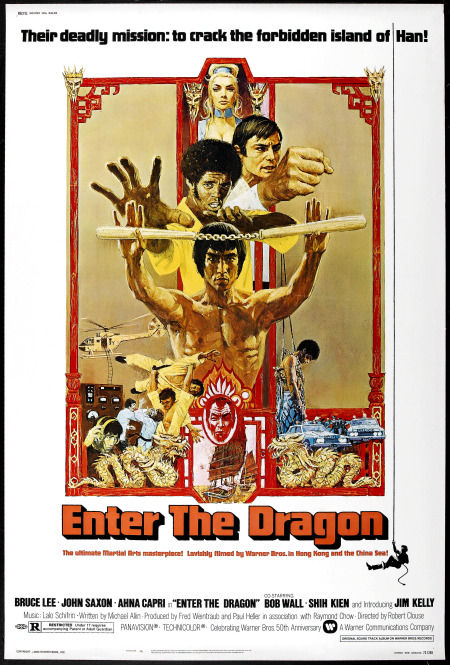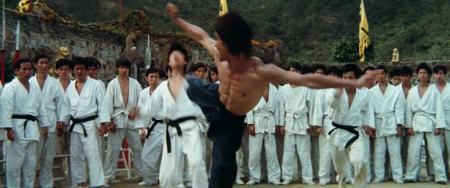40 Years a Dragon
 Friday, August 16, 2013 at 12:00PM
Friday, August 16, 2013 at 12:00PM  Hey all, it's Tim. The twin altars of worship at The Film Experience are Actresses and the Oscars, but I hope you’ll forgive me if I take a moment to go as far as possible in the opposite direction from either of those points, all the way to the land of grind houses and the classic age of chop socky martial arts film. For this weekend marks the fortieth anniversary of the U.S. release of the iconic Bruce Lee vehicle Enter the Dragon, and with the imminent North American debut of Wong Kar-wai’s The Grandmaster, the story “of the man who trained Bruce Lee”, as the ads insistently proclaim, it seems the ideal moment to visit a legendary film that, to my shame, I had never seen before.
Hey all, it's Tim. The twin altars of worship at The Film Experience are Actresses and the Oscars, but I hope you’ll forgive me if I take a moment to go as far as possible in the opposite direction from either of those points, all the way to the land of grind houses and the classic age of chop socky martial arts film. For this weekend marks the fortieth anniversary of the U.S. release of the iconic Bruce Lee vehicle Enter the Dragon, and with the imminent North American debut of Wong Kar-wai’s The Grandmaster, the story “of the man who trained Bruce Lee”, as the ads insistently proclaim, it seems the ideal moment to visit a legendary film that, to my shame, I had never seen before.
Stories don’t get a whole lot more basic: Han (Shih Kien) the shadowy crimelord owner of an island just barely grazing the edge of Hong Kong’s territorial waters has proclaimed a martial arts tournament, and among the many fighters in attendance are three whose private reasons for attending are revealed to us: Lee (Bruce Lee) has been sent by the British government, hunting for illegal arms and primed to get revenge for the life of his sister, killed by Han’s goons; Roper (John Saxon) is hoping to scare up a lot of money immediately before the mobsters he’s in debt to break his legs; Willam (Jim Kelly) is on the run from… racism? Anyway, he’s there too, and he’s old war buddies with Roper. In between scenes of the competitors fighting in the tournament, there are scenes of them fighting in the shadow recess of Han’s palace, attempting to take down his empire of evil. [more...]
Basically, there’s a lot of fighting, glued together by not very much story; and the story that’s there is more than a little bit dysfunctional. Three protagonists is three more than the movie’s terribly interested in following, and the script has a marked tendency to watch one man for just a little bit, lose interest, and switch over to another: a terrible way to build momentum, or to keep us invested in any individual plot arc.
The counterpoint to all of that is that only a madman would go to Enter the Dragon in the hopes of a scintillating, well-constructed story, and the movie banks on that, hard. It’s a delivery system for Bruce Lee fight scenes, and in the best movie star tradition, much of the film’s dramatic failure is offset, though never entirely fixed, by using the shortcut that we know Lee is the draw, so even if the first 40 minutes fail to effectively build a reason for him to be the protagonist, we’re certainly not confused as to who the movie’s about, or why.

The problem is more that the film is slow to develop – far slower than a contemporary viewer is likely to expect, but slow even by the standards of an early-‘70s kung-fu movie. Whether this had to do with the target audience (Enter the Dragon was the first martial arts movie made on American money for an explicitly American audience), I cannot say, but there’s a lot of fairly insubstantial and uninvolving character-building that goes on before the action part of the movie really starts up in earnest, making it hard to give the movie a pass on the grounds that it’s not meant to be good, it’s all about the fighting! That’s exactly true, and some more front-loaded fighting would make that a lot easier to handle.
That being said, the fighting is superb; even beyond one’s love or disinterest in seeing this kind of movie (and it’s a pretty terrific My First Kung-Fu Movie, far less violent or nonsensical than many of its Asian-made contemporaries), there is undeniable pleasure in observing somebody who is very good at something that is very hard to do, and Lee is better than very good.
Watching him fight isn’t unlike watching ballet, where the sheer precision and control he has over every inch of his body is utterly mesmerizing, as pure abstract motion, divorced from meaning or narrative. The fact that the fighting in the movie is exceptionally well-choreographed, and shot by director Robert Clouse with a sufficiently efficient lack of imagination that he doesn’t ever get around to stepping all over the action with too much camerawork, is just cake.

But everybody knows that Bruce Lee was a magnificent fighting artist and that Enter the Dragon showcases him marvelously; that’s the only thing that people tend to discuss when the movie comes up (that, or the amazing funk-exotic hybrid score by Lalo Schifrin, that great aural chronicler of early-‘70s urban cool). So instead of repeating all that for the umpteenth time, I’d like to wrap up by praising something that Enter the Dragon is virtually never credited for, which is its cinematography.
Madness, I know, yet Klouse and DP Gil Hubbs, neither of them prone to complex or rewarding visuals, manage to stumble across quite a bit of excellent imagery nonetheless; not least because Hubbs uses the exact same toolkit being employed to document American urban grit in the B-pictures of the time to film the more superficially exotic East Asian landscape and architecture. There’s something genuinely odd but rewarding about the metallic overtones of a blaxploitation film, with its saturation and docudrama griminess, being used to capture the bays of Hong Kong and the teaming humanity there; it reads as “authentic” in a way that Western films shot in Asia emphatically tend not to.

In the meanwhile, as much as the film relies on static, simple frames in the fighting sequences, there are some truly amazing establishing shots, which sounds like something you only say to be sarcastic, and yet I completely mean it: Enter the Dragon is rich with long shots that have a beautifully geometric quality to them, visually echoing the formalism and structure that the opening sequence imparts to the martial arts as a whole. Because it’s a kung-fu movie, so of course it has to describe the martial arts in some puffed-up, hushed way.

This isn’t a lost masterpiece of photography; nothing ridiculous like that. But it’s considerably more beautiful than most films of this genre and vintage, and this graphic appeal helps to keep the movie afloat through its stiff opening acts, while also providing a nice frame for the truly excellent fight scenes that make up the last half.
The film’s classic status owes more to its privilege of place as the first martial arts film to hit big in the States, than to its inherent merit; but it holds up as well as any other action movie from ’73. Not every film has to live up to its weighty legend to be involving entertainment, and while there are some restless patches in Enter the Dragon, I will give it this much credit: there’s never a moment that it’s boring.




Reader Comments (5)
i love seeing Bruce Lee kicking on the blog. haha. Keep pushing us out of our comfort zone, Tim.
This article reminds me that I also still haven't seen this film though when i was younger I LOVED that biopic "Dragon: The Bruce Lee story" with Jason Scott Lee (no relation)
If I remember correctly, Lee's sister actually killed herself so as not to be raped/murdered by Han's goons. And Jim Kelly - who has left us just a few weeks ago - I think runs away after kicking a few cops in their racist asses.
Nice write-up of the cinematography. The not always inspired but always expedient camerawork even makes the the film's madcap studio sets look quite appealing. I get nostalgic when I just think about them now.
I was at the post office in West L.A. and turned around and ran smack into a wall of rock solid manflesh. I almost fell over and he didn't budge at all. I looked up at the handsomest face I'd ever seen. Took me a second to realize it was Jason Scott Lee. Movie stars can really be that gorgeous in real life.
We're showing this, "Black Belt Jones," and a short film about Chicago martial arts studios tomorrow (Saturday) at the Chatham 14 in Chicago, in case you (Tim B) want to come down. Details here.
Tempting! I have seen and loved Black Belt Jones, and it's such a great film with a crowd. But alas, my Saturday dance card is all full up.
But anyone else reading this in the Midwest, you TOTALLY need to go, it's a magnificently goofy film.